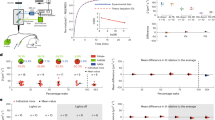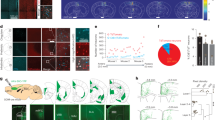Abstract
Recent findings on neural and endocrine rhythms in infant mice and rats show that maternal coordination has an important role in setting the phase of the developing circadian clock both in the fetus and soon after birth1–7. However, less information is available about the influence of the mother on activity/rest cycles of infants. Separation of the mother from infants in guinea pigs, monkeys and rats8–10 results in an increase in sleep disturbance (enhanced activity?). In this context it may be a common feature that during the postnatal period there is enhanced activity of pups during the hours when the mother is not nearby. Conversely, the social influences exerted by the mother while present with her young possibly leads to a relative rest stage. We have now tested this assumption in the night-active mouse Mus booduga. Our study addressed the postulate that the circadian activity/rest cycles of the pups are controlled by cyclic(?) presence and absence of the mother. The results reported here clearly indicate that the circadian locomotor activity of pups kept under continuous illumination or continuous darkness do entrain them to a regime of imposed 12:12-h cyclic presence and absence of the mother. The characteristics of this entrainment confer on the mother mouse the role of zeitgeber.
This is a preview of subscription content, access via your institution
Access options
Subscribe to this journal
Receive 51 print issues and online access
$199.00 per year
only $3.90 per issue
Buy this article
- Purchase on Springer Link
- Instant access to full article PDF
Prices may be subject to local taxes which are calculated during checkout
Similar content being viewed by others
References
Deguchi, T. Proc. natn. Acad. Sci. U.S.A. 72, 2814–2818 (1975).
Fuchs, J. L. & Moore, R. Y. Proc. natn. Acad. Sci. U.S.A. 77, 1204–1208 (1980).
Hiroshige, T., Honma, K. & Watanabe, K. J. Physiol., Lond. 325, 521–532 (1982).
Honma, S., Honma, K., Shirakawa, T. & Hiroshige, T. Endocrinology 114, 1791–1796 (1984).
Reppert, S. M. & Schwartz, W. J. Science 220, 969–971 (1983).
Takahashi, K., Murakami, N., Hayafugi, C. & Sasaki, Y. Am. J. Physiol. 246, R359–R363 (1984).
Viswanathan, N. & Chandrashekaran, M. K. Proc. Indian Acad. Sci. (Anim. Sci.) B93, 235–241 (1984).
Astic, L. & Jouvet-Mounier, D. J. Physiol., Paris 60, 389 (1968).
Hofer, M. A. & Shair, H. Devl Psychobiol. 15, 229–243 (1982).
Reite, M. & Short, R. A. Archs gen. Psychiat. 35, 1247–1253 (1978).
Rusak, B. & Boulos, Z. Photochem. Photobiol. 34, 267–273 (1981).
Author information
Authors and Affiliations
Rights and permissions
About this article
Cite this article
Viswanathan, N., Chandrashekaran, M. Cycles of presence and absence of mother mouse entrain the circadian clock of pups. Nature 317, 530–531 (1985). https://doi.org/10.1038/317530a0
Received:
Accepted:
Published:
Issue Date:
DOI: https://doi.org/10.1038/317530a0
This article is cited by
-
M K Chandrashekaran (1937–2009)
Resonance (2011)
-
M K Chandrashekaran (1937–2009)
Journal of Biosciences (2009)
-
The Zinc-Binding Protein Chordc1 Undergoes Complex Diurnal Changes in mRNA Expression During Mouse Brain Development
Neurochemical Research (2007)
-
Presence-absence cycles of the mother and not light-darkness are the zeitgeber for the circadian rhythm of newborn mice
Experientia (1989)
Comments
By submitting a comment you agree to abide by our Terms and Community Guidelines. If you find something abusive or that does not comply with our terms or guidelines please flag it as inappropriate.



